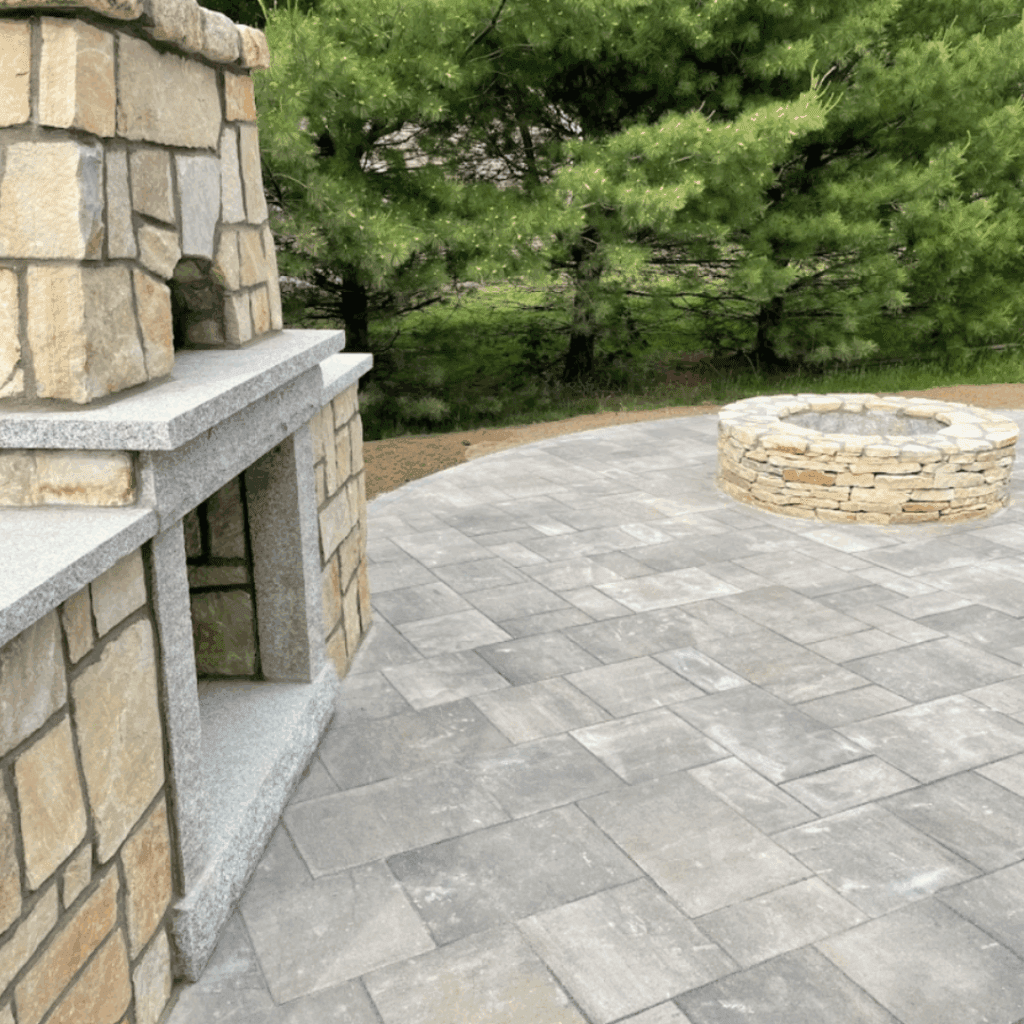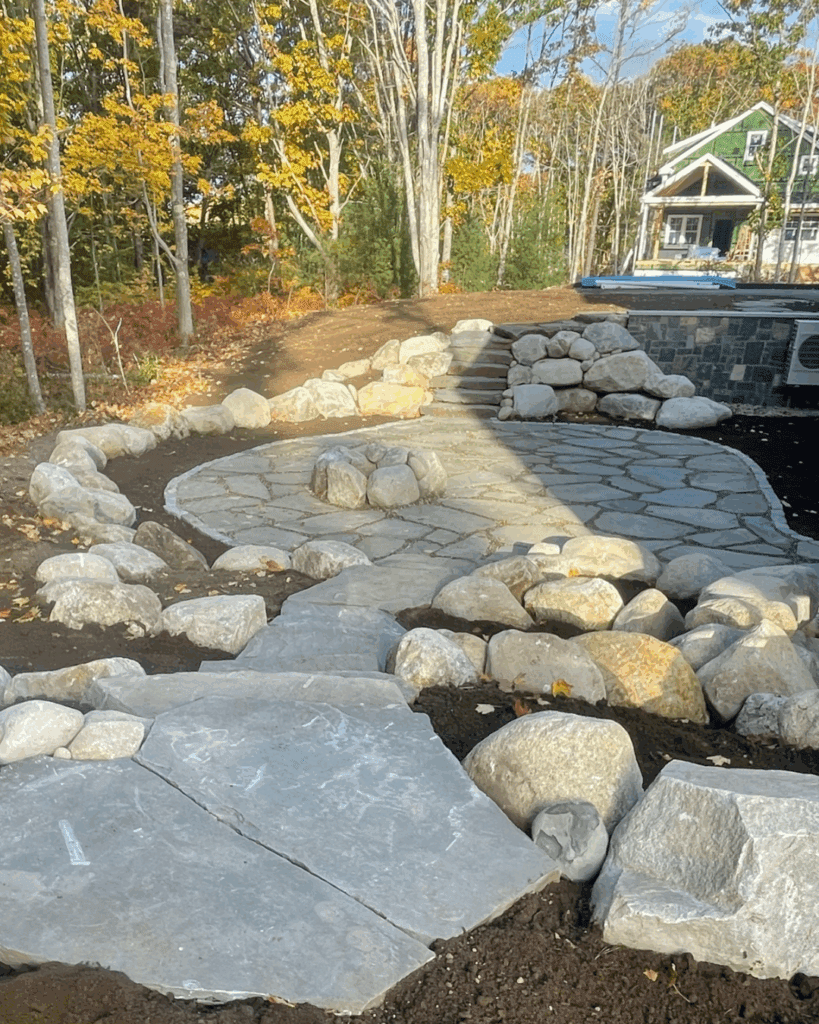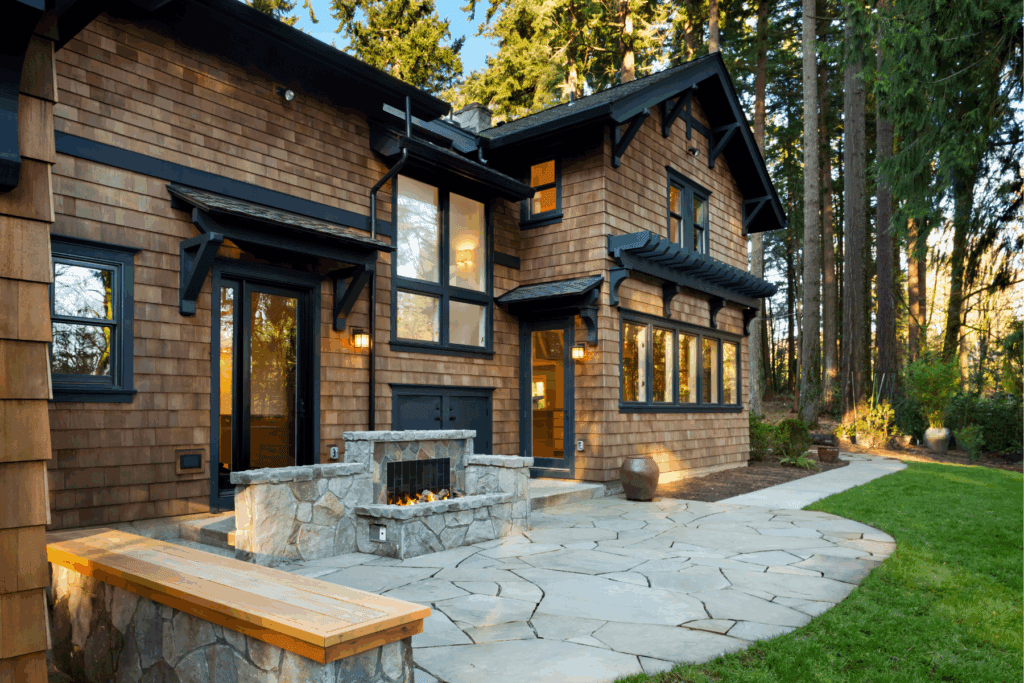Selecting the right material for your patio is a bit like choosing a spouse—you’re making a long-term commitment, and you’ll definitely notice if it doesn’t weather well over time. In Maine, where we experience all four seasons (sometimes in the same week), making an informed decision becomes even more important.
After three decades of creating custom hardscapes throughout southern Maine, we’ve guided hundreds of homeowners through this significant decision. We’ve seen which materials stand up to our notorious winters, which ones maintain their beauty with minimal care, and which options provide the best long-term value. We’ve also witnessed the occasional “what was I thinking?” moment when homeowners realize too late that their beautiful white pavers show every speck of dirt from the summer barbecue.
In this guide, we’ll compare the most popular patio materials available today, from natural stones like bluestone and granite to manufactured options like concrete pavers and brick. We’ll examine their strengths and limitations, helping you identify which material might be the perfect match for your property, lifestyle and budget—hopefully avoiding any future “irreconcilable differences” with your hardscape.
The Foundation of a Great Patio Starts with Material Selection
Your choice of patio material impacts everything from the overall look and feel of your outdoor space to its longevity, maintenance needs, and even how it feels underfoot on a hot summer day or cool autumn evening. The perfect material strikes a balance between beauty and practicality, between your design vision and the realities of Maine’s four-season climate.
When helping our clients select their ideal patio material, we consider several key factors. First, the material should complement your home’s architectural style and existing landscape elements. A contemporary home might call for clean lines and uniform pavers, while a historic colonial might be better suited to traditional brick or irregular bluestone. Your budget naturally plays a role, though we often remind clients that a quality installation using slightly more expensive materials can offer better long-term value than cutting corners.
The intended use of your space matters tremendously—will you primarily host elegant dinner parties, or do you need a robust surface that can handle children’s play equipment and heavy foot traffic? Southern Maine’s climate demands materials that can withstand freeze-thaw cycles without cracking or heaving, while your personal tolerance for maintenance should guide you toward either carefree options or those requiring periodic attention to maintain their beauty.
Let’s dive into the details of each popular patio material to help you make an informed decision.
Manufactured Pavers and Materials
Concrete Pavers: Versatility Meets Value
Concrete pavers have come a long way in recent years, with modern manufacturing techniques creating beautiful, durable options at attractive price points. These aren’t your grandmother’s plain gray concrete blocks—today’s pavers are the chameleons of the hardscape world, able to mimic the look of much pricier materials while keeping your bank account happier.

Advantages
- Extensive range of colors, shapes, textures, and patterns (more options than a coffee shop menu)
- More affordable than many natural stone options (your wallet will thank you)
- Uniform sizes make for easier installation (like working with Legos instead of puzzle pieces)
- Good durability in freeze-thaw conditions when properly installed
- Easy replacement of individual pavers if damaged (unlike that time you broke one tile in your bathroom and had to replace the whole floor)
Considerations
- Can fade over time, especially darker colors (think of it as a very slow suntan)
- May not have the same prestige as natural stone (if keeping up with the Joneses is your priority)
- Lower-quality pavers may be prone to cracking (as with most things in life, you get what you pay for)
- Surface can become slippery when wet if not textured (impromptu slip-and-slide not included)
Best Applications
Concrete pavers are versatile performers for almost any patio application. They’re particularly well-suited for homeowners who want design flexibility, easy maintenance, and good value. Modern manufacturing allows for pavers that convincingly mimic the look of natural stone—they’re the cubic zirconia of the patio world: beautiful, practical, and only an expert would know the difference.
Brick: Classic Appeal
Brick patios offer timeless charm and have been a traditional choice in New England for centuries. There’s something reassuringly familiar about brick—it’s the material that has watched generations of New Englanders come and go while maintaining its dignified appearance, like a distinguished elder statesman of hardscaping materials.

Advantages
- Warm, traditional appearance that complements classic architecture (like a cardigan sweater for your landscape)
- Extremely durable with a proven track record (some brick patios are older than the Declaration of Independence)
- Colors remain consistent with minimal fading (unlike those jeans you were promised wouldn’t bleed in the wash)
- Can be laid in numerous patterns for visual interest (herringbone, basketweave, running bond—it’s like Pinterest for your patio)
- Small unit size allows for creative designs and easy repairs (replace just what you need, not the whole thing)
Considerations
- Limited color palette compared to other options (fifty shades of red, but not much blue)
- Can develop moss or algae in shaded areas (though some find this adds to the charm)
- May heave during freeze-thaw cycles if not properly installed (southern Maine winters can be quite the dance partner)
- Tends to absorb moisture which can lead to cracking in severe winters (they’re tough, but not invincible)
Best Applications
Brick is ideal for traditional homes, colonial styles, and historic properties. It creates a warm, inviting patio surface that looks like it’s been part of the landscape for generations—because in many cases, it actually has been. If your home could wear a bow tie, brick would be its perfect match.
Natural Stone Options
Bluestone: Timeless Elegance
Bluestone has been a favorite among southern Maine homeowners for generations, and for good reason. This natural stone brings a timeless elegance to outdoor spaces that’s hard to match. The rich blue-gray tones with occasional purple undertones create a sophisticated palette that ages beautifully over time.

Advantages
- Exceptional durability that can last for decades, even in our harsh Maine winters
- Naturally non-slip surface that won’t turn your patio into an impromptu ice rink when wet
- Available in various cuts, from formal thermal to irregular shapes with organic edges
- Natural variations in color, ranging from deep blues to subtle grays and purples
- Thermal properties that keep it cooler in summer than many other materials (no “hot-foot dance” required)
Considerations
- Higher initial cost compared to manufactured pavers (quality rarely comes cheap!)
- Can be susceptible to staining without proper sealing (like a white shirt at a spaghetti dinner)
- Irregular pieces may require more skill to install
- Darker colors can get warm in direct sunlight (though rarely hot enough to fry an egg)
Best Applications
Bluestone is ideal for formal patios, pool surrounds, and walkways. Its natural color variations make it perfect for homeowners seeking a sophisticated, organic look that improves with age.
Granite: Unmatched Durability
Maine is known for its granite, and this locally sourced stone makes for incredibly durable and distinctive patios. If patios were superheroes, granite would definitely be wearing the indestructible cape. It’s the material that laughs in the face of Maine winters and still looks pristine when spring finally decides to show up.

Advantages
- Nearly indestructible – truly a lifetime investment (it will likely outlast the mortgage)
- Available in various finishes from rough-cut to polished (from “rustic charm” to “fancy enough for formal dinners”)
- Exceptional resistance to freeze-thaw cycles (it’s practically a native Mainer)
- Available in multiple colors and patterns for design flexibility
- Maintains its appearance with minimal maintenance (unlike that high-maintenance fern in your living room)
Considerations
- Higher price point than manufactured alternatives (quality comes at a cost, as your wallet will remind you)
- Installation requires specialized equipment due to weight
- Limited color palette compared to some options (though “granite gray” never goes out of style)
Best Applications
Granite is excellent for high-traffic areas, steps, and patios that need to withstand extreme weather conditions. It’s perfect for homeowners looking for a distinctly New England aesthetic that says, “Yes, I’m prepared for anything Mother Nature throws my way, and I’ll look good doing it.”
Flagstone: Natural Charm
Flagstone refers to flat stones that are irregularly shaped, offering a rustic, natural aesthetic that many Maine homeowners love. These stones bring a piece of nature’s artistry directly to your outdoor space, with no two pieces ever quite the same—much like snowflakes, but substantially more durable and far less likely to melt away by lunchtime.

Advantages
- Creates a casual, organic look perfect for gardens and woodland properties
- Available in various stone types (sandstone, limestone, slate) for different aesthetics
- Range of color options from reds and browns to grays and blues (Mother Nature’s color palette)
- Natural texture provides good traction in wet conditions (fewer surprise visits to the ground)
- Can be dry-laid in sand or mortared, depending on preference and budget
Considerations
- Irregular shapes may create wider, more noticeable joints (perfect for those tiny weeds looking for real estate)
- Some varieties can be prone to flaking in freeze-thaw cycles (they’re not all built for the Maine lifestyle)
- May require more maintenance in our Maine climate
- Installation is labor-intensive and requires skill
Best Applications
Flagstone works beautifully for garden patios, walkways, and rustic outdoor spaces. It’s ideal for homeowners seeking an informal, natural look that blends with the landscape rather than dominating it.
Factors to Consider When Making Your Selection
Climate Compatibility
In southern Maine, our harsh winters and freeze-thaw cycles demand materials that can handle extreme temperature fluctuations without cracking, spalling, or heaving. The big question to ask yourself: “Will this material still look good after surviving a typical Maine winter?”
Some materials stand up better than others in our climate:
- Granite: The heavyweight champion of winter durability
- Bluestone: Excellent freeze-thaw resistance when properly installed
- High-quality concrete pavers: Engineered specifically for cold climates
Materials that absorb significant amounts of water can be problematic in our freeze-thaw environment, potentially leading to cracks and deterioration over time. This is why professional installation with proper drainage is just as important as material selection.
Maintenance Requirements
Be honest with yourself about how much maintenance you’re willing to perform to keep your patio looking its best. Some materials require little more than occasional sweeping and rinsing, while others benefit from regular sealing or specialized cleaning.
The maintenance spectrum generally looks like this:
- Low maintenance: Granite and high-quality concrete pavers
- Moderate maintenance: Bluestone and brick (with occasional resealing)
- Higher maintenance: Some varieties of flagstone, especially softer stones
Remember, even “low maintenance” doesn’t mean “no maintenance.” Consider your lifestyle and how much time you realistically want to spend caring for your outdoor space. If your idea of patio maintenance is “brush off the grill and open a beer,” you might want to stick with granite or concrete pavers.

Aesthetic Harmony
Your patio should feel like a natural extension of your home, complementing its architectural style rather than competing with it. We’ve found certain pairings tend to create harmonious connections between home and landscape.
Colonial or traditional homes in southern Maine often pair beautifully with classic materials like brick, which echoes historical construction methods, or bluestone, whose subdued elegance complements traditional architecture. Contemporary homes can shine with the clean lines of granite or the geometric precision of modern concrete pavers.
Coastal cottages often benefit from bluestone’s natural hues that echo the ocean or light-colored pavers that reflect the brightness of beach environments. For rustic retreats and cabins, irregular flagstone or heavily textured pavers help maintain the natural, unrefined aesthetic that makes these homes special.
Budget Considerations
Let’s face it—budget matters. Natural stone typically represents a higher initial investment but often delivers greater longevity and timeless appeal. Think of it as the difference between buying a classic piece of furniture versus something trendy but temporary.
Your budget tiers generally look like this:
- Premium: Granite and high-end bluestone
- Mid-range: Standard bluestone, quality concrete pavers
- Budget-friendly: Standard concrete pavers, brick
It’s worth remembering that installation costs often exceed material costs, so choosing a slightly more expensive but longer-lasting material can actually be more economical in the long run. A well-constructed patio using premium materials might cost 15-20% more initially, but could last decades longer than a budget installation.
Creating Distinctive Designs Through Material Combinations
Who says you have to commit to just one material? Some of the most stunning patios we’ve created for southern Maine homeowners feature thoughtful combinations that bring out the best in each element. It’s like creating the perfect playlist—sometimes you need a little variety to hit all the right notes.
Consider the classic combination of bluestone and brick, where brick borders create defined edges around bluestone’s natural beauty. This pairing is like peanut butter and jelly—a time-tested combination that simply works. For a more dramatic statement, incorporate granite steps or features into a paver patio. The contrast draws the eye and creates natural focal points, much like that one friend who somehow makes the whole room more interesting just by showing up.
Playing with multiple paver colors can create patterns and visual interest without breaking the bank. We’ve designed everything from simple borders to elaborate compass roses and custom monograms. Think of it as giving your patio its own signature style—without the designer price tag of a complete natural stone installation.
Stone inlays and decorative medallions can transform an ordinary patio into a conversation piece. These focal points are like statement jewelry for your hardscape—they don’t need to be large to make a big impact.
Making the Final Decision
When you’re ready to select your patio material, don’t rush the decision. After all, this is a relationship that should last decades—longer than most car loans and many marriages in America. We recommend these steps to ensure you find your perfect match.
- See samples in person. This isn’t online dating where reality often differs from the profile picture. Colors and textures look dramatically different in real life than they do on a computer screen or in a brochure. What appears as a subtle beige online might look more like “radioactive sand” in natural sunlight.
- Visit completed projects in your area if possible. This gives you the chance to see how materials weather in our Maine climate and how they pair with architectural styles similar to yours.
- Consider your total environment. How will the material work with your existing landscaping, house color, and surroundings? The most beautiful patio in the world will still look out of place if it clashes with your home’s style like plaid pants with a polka dot shirt.
- Think long-term. Trends come and go faster than Maine’s spring, but your patio will be with you for years. Will you still love this material when the current home design shows have moved on to the next big thing? Choose materials with timeless appeal.
- Consult with professionals who understand the unique challenges of building in Maine. An experienced hardscaper can provide insights specific to your property’s soil conditions, drainage needs, and exposure—factors that significantly impact which materials will perform best in your particular situation.
The Stone Solutions Maine Difference
At Stone Solutions Maine, we understand that selecting the perfect patio material is just the first step in creating your dream outdoor space. Our experienced team works closely with you throughout the entire process, from material selection to final installation.
Our expert stonemasons and hardscape professionals bring decades of experience working specifically with Maine’s unique conditions. We’re committed to quality craftsmanship that ensures your patio will stand the test of time, regardless of which material you choose.
Ready to explore your options and start designing your perfect patio? Contact us today to schedule a consultation. We’ll help you navigate the “stone showdown” and select the ideal material for your unique southern Maine property.

